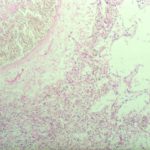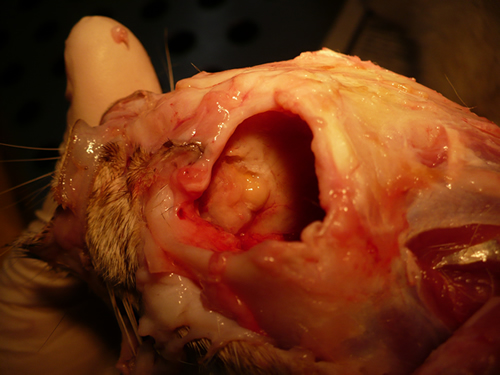Date: 26 November 2013
Nasal, sinus and orbital aspergillosis in a cat. The left nasal cavity and sinus were full of pus and debris and there was severe bone erosion from the nasal cavity into the rostromedial orbitthrough which pus was protruding
Copyright:
(Kindly provided by Martin L. Whitehead, BSc, PhD, BVSc, CertSAM, MRCVS & Peter W. Kettlewell, BVSc, MSc, MRCVS. Chipping Norton Veterinary Hospital, Albion Street, Chipping Norton, Oxon, OX7 5BN.)
Notes:
History : Nasal aspergillosis is relatively common in dogs but rare in cats. Our veterinary hospital in Oxfordshire was recently presented with a 13-year old female Burmilla cat with a history of left-side unilateral nasal discharge, a watery left eye with slight blepharospasm, occasional ‘twitching movements’ of the head, weight loss, inappetance and depression. Clinical examination was unremarkable except for left-side mucopurulent nasal discharge, left-side mild serous ocular discharge, and a soft subcutaneous swelling over the left frontal sinus. Haematology, blood biochemistry and urinalysis revealed diabetes mellitus but was otherwise unremarkable. Radiography under general anaesthesia revealed a diffuse soft tissue density within the left nasal cavity and left frontal sinus. Rhinoscopy revealed mucopurulent discharge on the left side but was otherwise unremarkable. Aspiration of the swelling over the left frontal sinus produced pus and this abscess was lanced and flushed. The frontal sinus was trephined and the sinus and nasal cavity flushed with saline. Tests for feline immunodeficiency virus and feline leukaemia virus and serology for Aspergillus were not carried out. The cat was started on insulin, ibafloxacin (Ibaflin, Intervet) and meloxicam (Metacam, Boehringer). Cytology of the material flushed from the frontal sinus and nasal cavity revealed fungal hyphae consistent with Aspergillus species and culture of this material yielded growth of a fungus which was morphologically similar to A. candidus (Awaiting molecular typing results). The cat was then started on oral itraconazole (Itrafungol, Janssen) 10 mg/kg p.o. SID. The abscess over the rostral frontal sinus did not heal and a second abscess appeared over the nasal bone just dorsal to the nose. Infusion of the frontal sinus and nasal cavity with topical antifungal medication was discussed with the owners, but as the cat was deteriorating they requested euthanasia. On post-mortem examination the right nasal cavity, frontal sinus and orbit were unaffected. The left nasal cavity and sinus were full of pus and debris and there was severe bone erosion from the nasal cavity into the rostromedial orbit through which pus was protruding. There was also severe bone erosion rostrally through the nasal bone and less severe bone erosion dorsally over the rostral part of the frontal sinus, these sites of bone erosion being at the location of the two subcutaneous abscesses.Feline nasal aspergillosis is extremely rare in the UK and to our knowledge this is the first reported case of orbital aspergillosis in the UK although nasal aspergillosis has been reported in other countries.
Images library
-
Title
Legend
-
Pulmonary aspergillosis (cow 2). Taken from the edge of a lesion, as described in the previous image for cow 2.
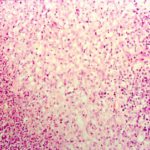
-
Pulmonary aspergillosis (cow 2). Section of lung from a 2 year old cow with weight loss and anorexia since calving. On necropsy examination, multiple firm masses were identified throughout the lungs. These were cavitating in nature, with a necrotic centre and peripheral fibrosis. Both this section and the following one are taken from the edge of such a lesion and demonstrate the pyogranulomatous inflammatory response.
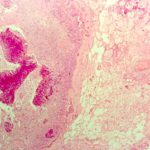
-
Guttural pouch aspergillus (PAS) (horse TW). Serial section of previous slide for horse TW stained by PAS reveals the presence of fungal hyphae within the inflammatory tissue. Aspergillus spp. is the likely cause of equine guttural pouch mycosis.
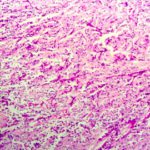
-
Guttural pouch aspergillosis (horse TW). Section of the wall of the guttural pouch from an 8 year old, neutered male horse with recurrent right-sided epistaxis of 10 days duration. Endoscopic examination confirmed the origin of the blood to be the guttural pouch and the right internal carotid artery was ligated surgically. Necropsy examination revealed an extensive ruptured aneurysm of this vessel and guttural pouch mycosis. The section reveals necrosis and chronic inflammatory infiltration of guttural pouc

-
Pulmonary aspergillosis. Section of lung from a 6 year old, Holstein cow with mycotic pneumonia attributed to Aspergillus spp.
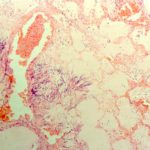
-
Meningitis (dog R). Grocott-stained serial section of the previous slide for dog R reveals the presence of fungal material at the centre of each microgranuloma. These lesions were not cultured, but Aspergillus spp. was identified by immunohistochemical examination using a panel of specific antisera. There was no evidence of systemic involvement in this dog.
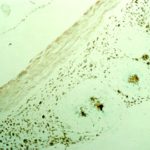
-
Aspergillus meningitis (dog R). Section of spinal meninges from a 4 year old, neutered female German shepherd dog with multiple discospondylitis involving T1-2, T6-7, T10-11 and L5-6. There are a series of coalescing microgranulomas associated with meninges at each site.
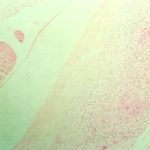
-
Pulmonary aspergillosis (cat T). Section of lung from a young adult, female domestic short haired cat. This was one of seven unvaccinated farm cats that died over a 12 month period. At necropsy examination there was diffuse pulmonary consolidation with scattered abscessation. Aspergillus spp. was cultured from these lesions. The cat also had histopathological evidence of lymph node atrophy, a change that may be attributed to feline immunodeficiency virus (FIV) infection.

-
Pulmonary aspergillosis (PAS) (parrot C). Section of lung from parrot C stained by periodic acid schiff (PAS) demonstrating the hyphal material. Aspergillus spp and Bacillus cereus were cultured from the lesions.
